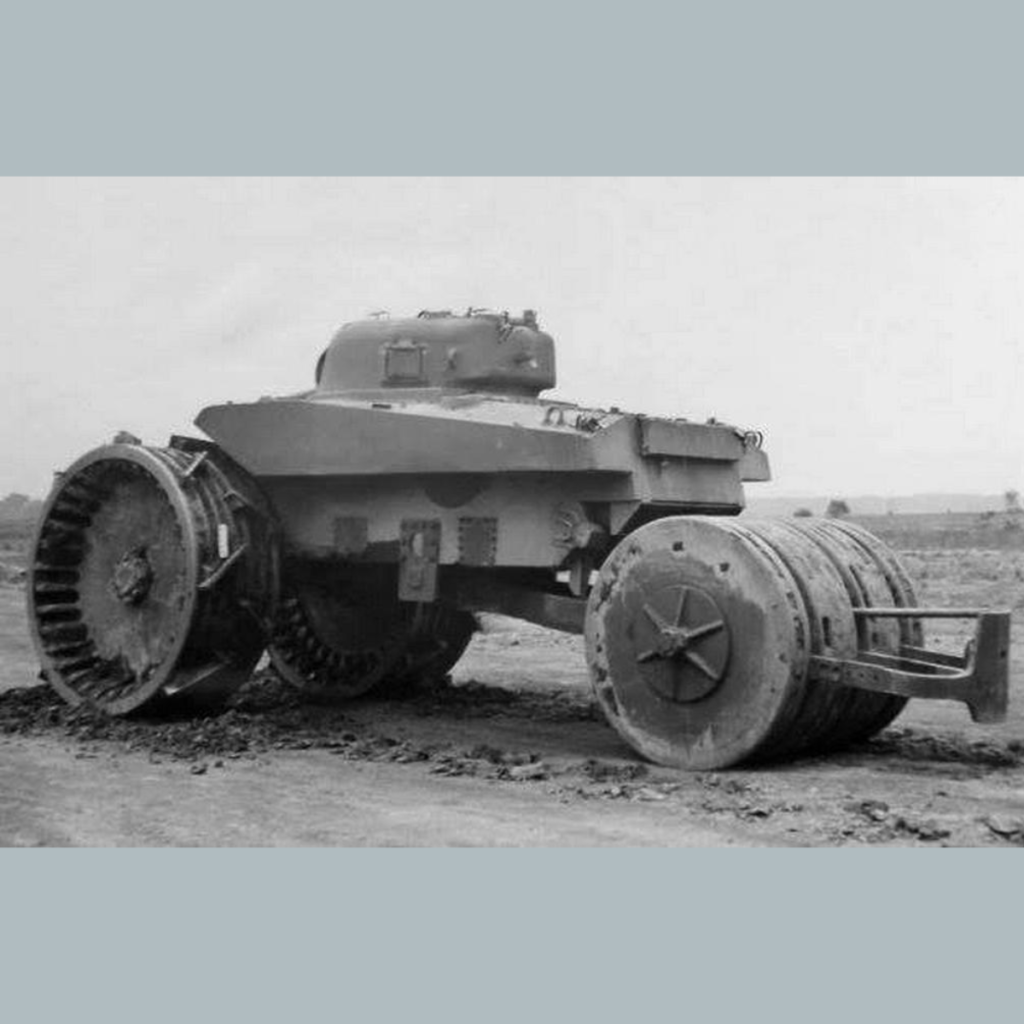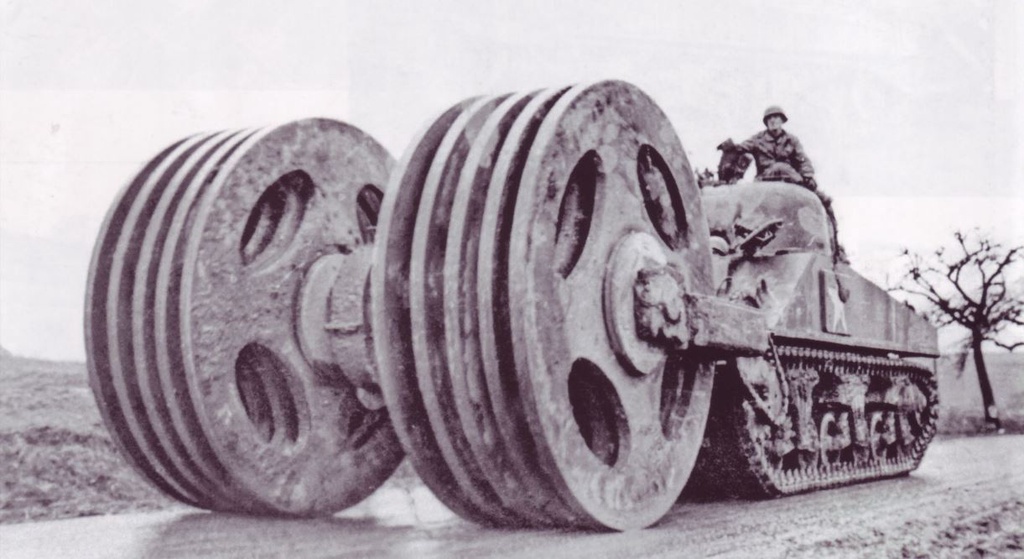

History:

 |
| German minefield |
 |
| Matilda Scorpion mine flail tank |
 |
| Valentine Scorpion mine flail tank prototype |
 |
| Sherman Crab mine flail tank |
 |
| TI mine exploder fitted to the M3 tank |
 |
| TI mine exploder fitted to the M3 tank – side view |

The exploder proved effective, but an operational perspective, field-changing an expendable wheel would be much easier, faster, and less expensive than replacing a far more complex self-powered wheel. This unorthodox complication was fortunately dropped in favor of a more practical approach when the Tricycle concept evolved into the T10 Mine Exploder. Prototyped by the Fisher Body Division of General Motors in Grand Blanc, M1, the pilot vehicle was an adaptation of the Sherman M4A2 large hatch/ high bustle turret.
 |
| font: http://the.shadock.free.fr/sherman_minutia |
 |
| font: http://the.shadock.free.fr/sherman_minutia |
The tank body was stripped of its tracks and running gear so that its front-mounted differential could be coupled (through a projecting pinion gear) to the oversize slotted wheels. The M4A2 high bustle turret with its 75mm gun was operationally retained, though presumably of no tactical use when the vehicle was remotely operated.
 |
| M4A2 T10 mine exploder – side view |
 |
| M4A2 T10 under transport with normal VVSS suspensions Notice the mine exploder wheel in the rear (red arrow) font: http://the.shadock.free.fr/sherman_minutia |
 |
| M4A2 T10 under transport with normal suspensions – rear view Notice the high bustle turret (green arrow) and rear wheel T10 support (red arrow) font: http://the.shadock.free.fr/sherman_minutia |
Two 2.438mm diameter rollers were mounted at the front of the tank driven by additional gearing from the final drive. Each of the front rollers was 93cm wide and the gap between them was covered by a 1.828mm diameter double roller trailing at the rear of the tank. This arrangement moved the bottom of the hull up to 1.410mm above the ground. A path 3.810mm wide was covered and the overall weight was 52.800Kg. The T10 moved at 3,2 Km/h when exploding mines and could reach a maximum of 11 Km/h on roads.

Several types of wheels and various accessories were tested … In the initial tests, the wheels accumulated mud in the void spaces between them, preventing them from penetrating the ground, reducing their effectiveness of mine mines:
 |
| T10 “early version: Notice the absence of the “cleaning stars” acting on the rear wheels gaps. The mud turns the discs into a large cylindrical wheel. The front wheels shows transverse claws to increase traction, but the mud fills everything… Compare a photo above with an improved version below |
 |
| T10 “late version” – Rear left view – Notice the “stars” which removed the mud from the spaces between the wheels … |
 |
| T10 “late version” – Rear right view |
 |
| T10 “late version” – Notice the “stars” which removed the mud from the spaces between the wheels … |
Specs:
| M4A2 T10 Mine Exploder | |
|---|---|
|
Type
|
Mine exploder tank
|
|
Place of origin
|
USA
|
|
Service history
|
|
|
In service
|
prototype (1944)
|
|
War
|
World War II
|
|
Production history
|
|
|
Designed
|
1940
|
|
Manufacturer
|
Fisher Body- Division of General Motors |
|
No. built
|
1
|
|
Specifications
|
|
|
Weight
|
52.800 Kg
|
|
Length
|
8,74 m
|
|
Width
|
3,81 m
|
|
Height
Ground clareance
|
3,58 m
1.410mm
|
|
Crew
|
remoted controled or 5 (commander, gunner, loader, driver, co-driver)
|
|
|
|
|
Armor
|
93 mm (3.7 in) effective against 7.5 cm APCBC with cast glacis
118 mm (4.6 in) effective against 7.5 cm APCBC with 47° RHA glacis
|
|
Main armament
|
75 mm M3 L/40 gun (90 rounds)
|
|
Sec. armament
|
.50 cal Browning M2HB machine gun (300 rounds),
2×.30-06Browning M1919A4machine guns (4,750 rounds)
|
|
Engine
|
G.M. 6046twin inline diesel; 375 hp @ 2,100 rpm
|
|
Power/weight
|
6,6 hp / metric ton
|
|
Suspension
Fuel capacity
|
2 front wheels and 1 rear wheel
560 liters
|
|
Operational range
|
241 km at 560 L; Diesel
|
|
Speed
|
11 km/h
|